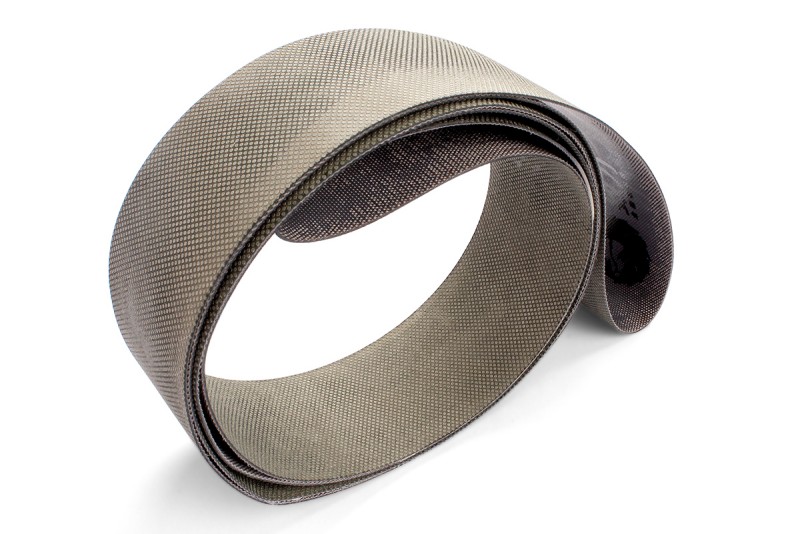In the textile finishing industry, achieving high-quality finishes while maintaining efficiency is critical. Conventional abrasive belts have long been used for processes such as sanding, but they often fall short in terms of durability, consistency and overall performance. Diamond-coated abrasive belts have emerged as a superior alternative that addresses the shortcomings of conventional abrasive belts and delivers superior results.
1. Unparalleled durability and longevity
One of the most significant advantages of diamond abrasive belts is their unparalleled durability.
Hardest material: Diamond is the hardest material known, which means diamond coated belts stay sharp longer than traditional abrasives.
Extended service life: Tests show that diamond belts last 50-70% longer than conventional belts. Longer service life reduces the frequency of replacement, minimizes downtime, and thus increases production efficiency.
2. Consistent, high-quality finishing
In textile processing, achieving a uniform surface is crucial and diamond abrasive belts excel in this regard.
Uniform grit distribution: The grit on the diamond belt is evenly distributed, ensuring consistent wear across the entire fabric width.
Eliminates streaking: This uniformity helps eliminate streaking and maintains texture consistency even over time. As a result, manufacturers can achieve high-quality finishes that satisfy discerning customers.
3. Heat resistance and fabric protection
The heat generated during the sanding process can damage the integrity of the fabric, especially with delicate materials.
High thermal conductivity: Diamond’s excellent thermal conductivity enables it to dissipate heat efficiently.
Anti-scorching: This property prevents scorching and protects the fabric, making diamond abrasive belts particularly suitable for machining fine synthetic blends that are sensitive to heat.
4. Cost efficiency and sustainability
While the initial investment in diamond belts may be higher than traditional options, the long-term benefits far outweigh the costs.
Long-term savings: Extended diamond belt life can save 30-40% in abrasive costs over the long term. Fewer changes means lower overall costs for manufacturers.
Reduced waste: In addition, less frequent belt changes help reduce waste and support sustainable production practices. This is in line with the textile industry’s growing focus on environmental responsibility.
Technical specifications for optimal teaching performance
In the textile finishing industry, achieving the best possible sanding results is essential to maintaining product quality and efficiency. The choice of abrasive belts plays a vital role in this process. To maximize the efficiency of the sander, specific diamond belt specifications are recommended. This article outlines these specifications and, through a case study, demonstrates the advantages of using diamond belts in a textile manufacturing environment.
Recommended belt specifications
1. Abrasive particle size: 220
Balance of finishing and material removal: 220 grit sandpaper provides an ideal balance between fine finishing and efficient material removal. This grit is particularly suitable for achieving a soft, even texture on fabrics, which is essential for high-quality textiles.
2. Width: 75mm
Industrial machine standard: The standard width of industrial edgers is 75 mm. This specification ensures complete coverage of the fabric during the edging process, resulting in consistent results across the entire fabric width.
3. Length: 6600 mm
Accommodates large fabric rolls: The 6600 mm belt length is optimal for accommodating large fabric rolls. This length minimizes the need for splicing, avoiding downtime and production interruptions. The longer belt allows for continuous operation, which increases overall efficiency.
4. Quantity: 24 rolls
Bulk production is economical: Purchasing diamond belts in batches of 24 rolls is a cost-effective strategy. This quantity ensures that manufacturers have sufficient inventory, which promotes continuous production and reduces the frequency of restocking.
Case study: Improving efficiency in a textile mill
A European textile manufacturer recently made a major upgrade to its grinding operations by replacing the traditional silicon carbide belts in its grinding machines with 220-grit diamond belts. The results of this upgrade were dramatic, highlighting the benefits of using diamond belts:
50% longer belt life: Diamond belts last 50% longer than conventional silicon carbide belts. This extended durability significantly reduces the manufacturer’s annual abrasive costs.
30% reduction in energy consumption: With the use of diamond belts, energy consumption is reduced by 30% due to reduced friction during the grinding process. This not only reduces operating costs, but also helps to create a more sustainable production environment.
Zero fabric burning incidents: One of the most notable improvements is the elimination of fabric burning incidents. The high thermal conductivity of the diamond belt effectively dissipates heat, protecting the integrity of delicate fabrics and improving the overall quality of the product. Fewer defects also reduce waste, further enhancing the manufacturer’s sustainability capabilities.
Special offer: Diamond emery belts for peaching machines
Product details
Product: High quality diamond abrasive belt
Courage: 220
Dimensions: 75 mm (W) x 6600 mm (L)
Quantity: 24 volumes
Why choose our diamond belt?
1. Customizable grit and size: We understand that different types of fabrics require specific treatments. Our diamond abrasive belts can be customized to your unique needs, ensuring optimal performance for a variety of materials.
2. ISO certified manufacturing: Quality is our top priority. Our diamond abrasive belts are manufactured in an ISO certified facility, ensuring consistent quality and reliability in every roll. You can trust that our products will meet the highest industry standards.
3. Fast global delivery: We understand that minimizing downtime during production is critical. Our efficient logistics ensure fast global delivery, so you receive your belts in a timely manner and keep your operations running smoothly.
Post time: May-23-2025

